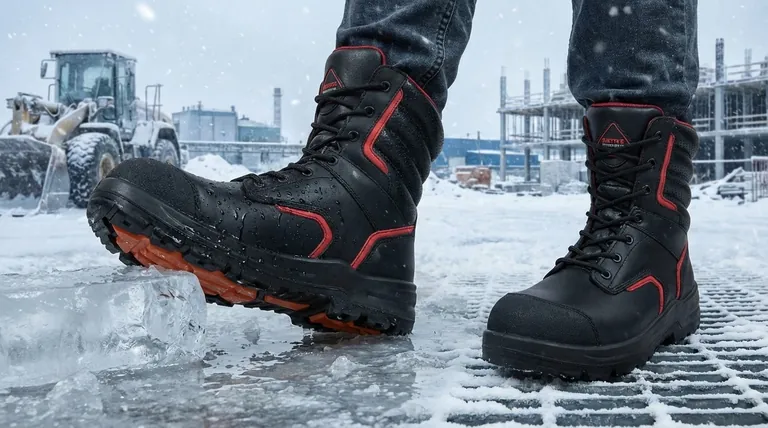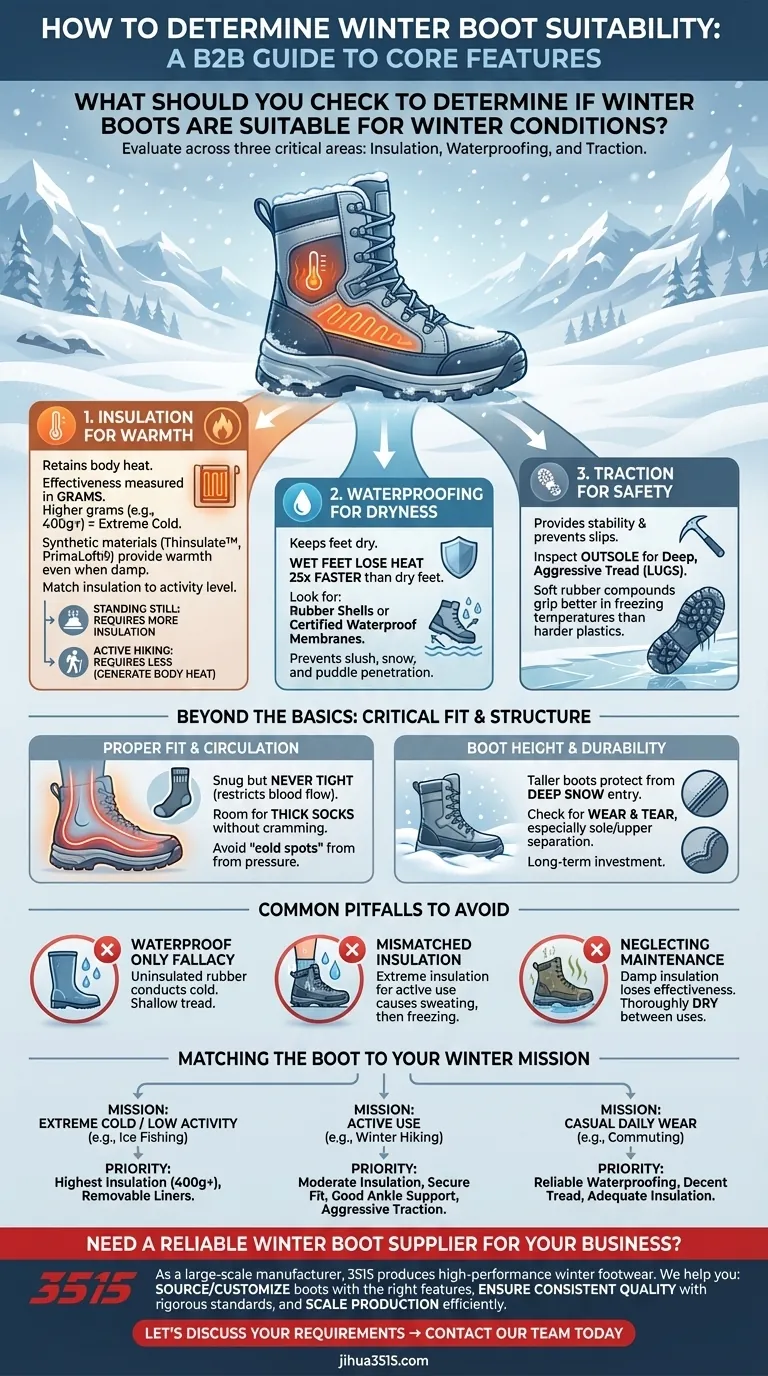To determine a winter boot's suitability, you must evaluate it across three critical areas: its insulation for warmth, its waterproofing for dryness, and its outsole traction for safety. A boot that fails in any one of these core functions will not perform reliably in true winter conditions, regardless of its other features.
The most common mistake is evaluating a winter boot's features in isolation. A truly effective winter boot is a complete system where insulation, waterproofing, fit, and traction work together to match your specific climate and activity level.

The Three Pillars of Winter Performance
A winter-ready boot is built on a foundation of three essential performance characteristics. Each must be assessed to understand the boot's capabilities.
Pillar 1: Insulation for Warmth
Insulation is what keeps your feet warm, and its effectiveness is often measured in grams. Higher gram counts, like 400g or more, are designed for more extreme cold.
Common insulation types include synthetic materials like Thinsulate or PrimaLoft, which provide warmth even when damp.
The right amount of insulation depends on your activity. A person standing still requires significantly more insulation than someone actively hiking, who generates their own body heat.
Pillar 2: Waterproofing for Dryness
Staying dry is just as important as staying warm. Wet feet lose heat up to 25 times faster than dry feet, rendering even the best insulation useless.
Look for boots constructed with inherently waterproof materials, such as rubber shells, or those featuring a certified waterproof membrane.
Waterproofing is essential for navigating slush, wet snow, and puddles, which are common in many winter environments.
Pillar 3: Traction for Safety
A winter boot's sole is its connection to the ground. A lack of traction on ice and snow is a serious safety hazard.
Inspect the outsole for a deep, aggressive tread pattern (often called lugs). These deep grooves are designed to bite into snow and provide stability.
The material of the sole also matters. Softer rubber compounds tend to remain more flexible and grip better in freezing temperatures compared to harder plastics.
Beyond the Basics: Critical Fit and Structure
Even with the right materials, the boot's physical design and how it fits your foot can make or break its performance.
The Importance of a Proper Fit
A winter boot should fit snugly but never tightly. A fit that is too tight restricts blood circulation, which is a primary source of warmth for your feet.
You must be able to comfortably wear a pair of thick wool or synthetic socks inside the boot without your toes being crammed.
Check for any "cold spots" where your foot presses too firmly against the boot wall, as these areas will get cold first.
Boot Height and Construction
Taller boots provide more protection from deep snow, preventing it from entering over the top and making your feet wet and cold.
Examine the boot for signs of wear and tear, especially separation between the sole and the upper. A durable, well-made boot is a long-term investment in safety and comfort.
Common Pitfalls to Avoid
Choosing the wrong boot often comes from overemphasizing one feature at the expense of the others.
The "Waterproof Only" Fallacy
Standard rain boots (like Wellingtons) are excellent at keeping feet dry but are a poor choice for cold conditions.
They are typically made of uninsulated rubber, which conducts cold directly to your foot. Their tread is also often shallow and not designed for icy surfaces.
Mismatched Insulation for Your Activity
Wearing an expedition-grade boot with extreme insulation for an active pursuit like winter hiking can be a mistake.
Your feet will sweat profusely, and that moisture will eventually make you colder once you stop moving. Balance insulation with your expected energy output.
Neglecting Proper Maintenance
You must thoroughly dry your boots between each use. Damp insulation loses its effectiveness and can lead to odor and material degradation.
Matching the Boot to Your Winter Mission
Use your primary goal to guide your decision, focusing on the features that matter most for your specific needs.
- If your primary focus is extreme cold and low activity (e.g., ice fishing): Prioritize the highest insulation rating (400g and above) and features like removable inner liners for maximum warmth.
- If your primary focus is active use (e.g., winter hiking, snowshoeing): Balance a moderate insulation level with a secure fit, good ankle support, and an aggressive, high-traction outsole.
- If your primary focus is casual daily wear (e.g., commuting in slush): Focus on a reliable combination of waterproofing, decent tread for slippery sidewalks, and enough insulation for short-term exposure to cold.
By understanding how these elements form a system, you can confidently select a boot that will keep you warm, dry, and safe all winter.
Summary Table:
| Key Feature | What to Look For | Why It Matters |
|---|---|---|
| Insulation | Gram weight (e.g., 400g), synthetic materials (Thinsulate™) | Retains body heat; higher weight = warmer for less activity. |
| Waterproofing | Waterproof membrane, rubber shell construction | Keeps feet dry; wet feet lose heat 25x faster. |
| Traction | Deep, aggressive tread pattern (lugs), soft rubber compound | Provides stability and prevents slips on ice and snow. |
| Fit & Structure | Snug but not tight fit, room for thick socks, tall shaft | Ensures proper circulation and protection from deep snow. |
Need a reliable winter boot supplier for your business?
As a large-scale manufacturer, 3515 produces a comprehensive range of high-performance winter footwear for distributors, brand owners, and bulk clients. Our production capabilities encompass all types of insulated, waterproof, and safety-rated boots designed to meet the demands of any winter climate and activity level.
We can help you:
- Source or customize boots with the right balance of insulation, waterproofing, and traction for your target market.
- Ensure consistent quality and durability with our rigorous manufacturing standards.
- Scale production efficiently to meet your volume needs.
Let's discuss your specific requirements → Contact Our Team Today
Visual Guide

Related Products
- Premium Wholesale Waterproof Safety Boots High Performance Protection for Industrial Markets
- Wholesale Safety Footwear Manufacturer for Bulk & Custom OEM Orders
- High Performance Fire-Retardant Waterproof Safety Boots
- Customizable Anti-Smash Safety Boots for Wholesale & Private Label Manufacturing
- Custom Wholesale Leather Safety Boots Direct Factory Manufacturing
People Also Ask
- What are some real-world examples of safety footwear preventing injuries? Protect Your Workforce Effectively
- What is the primary purpose of safety shoes? Your Ultimate Guide to Workplace Foot Protection
- How do safety shoes protect you? A Guide to Essential Footwear Safety Features
- What are some examples of footwear requirements in different work settings? Ensure Safety and Compliance
- What is the OSHA standard for safety-toe boots? Ensuring Compliance and Worker Protection



















